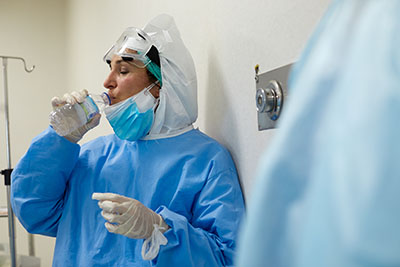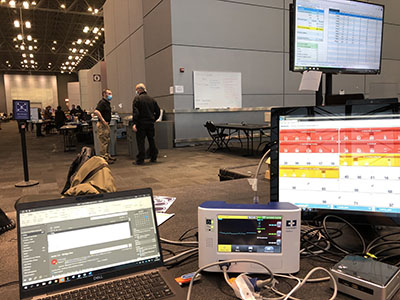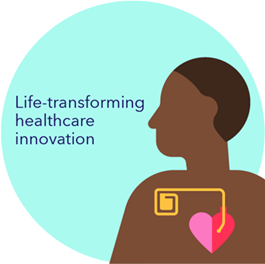

Medtronic stories
Helping Hospitals Get Back To Business
Medtronic is bringing healthcare leaders together to share successful strategies for fighting COVID-19 and navigating a new era of in-patient care.
The COVID-19 pandemic created two separate but related global disasters — a public health crisis and an economic crisis. Unfortunately, hospitals bore the brunt of both.
Today, elective procedures are resuming, the backlog of cases is shrinking, and most importantly, hospitals are learning how to effectively treat COVID-19 patients while keeping everyone safe.
Still, the road to recovery is a long one riddled with detours as the virus surges around the globe. The pandemic fundamentally has changed the way healthcare is delivered. Virtual doctor visits are extremely popular. Packed waiting rooms are not.
Seven months into the pandemic, Medtronic is thinking beyond business as usual and looking for new ways to support providers and patients. To help everyone navigate this new normal, the company is committed to providing helpful resources and fostering important conversations that will help healthcare systems bounce back.

Medtronic is gathering resources, solutions, and best practices and making them available to healthcare leaders via an online COVID-19 Recovery Resource Center. There, health system leaders can find the latest information about hospital safety protocols, staff wellness support information from ComPsych — the world’s largest provider of employee assistance programs — and downloadable tools to keep staff engaged and resilient during these stressful times. And for patients in the United States, Medtronic created Destination Health, an online resource that provides answers to frequently asked questions about seeking care during the pandemic.
Last month, Medtronic and Harvard Business Review (HBR) sponsored a three-part virtual forum series, bringing together more than 100 executives from some of the top health systems in the United States. Together, they confronted important pandemic-related topics including patient safety, telehealth, financial agility, and operational effectiveness.
“One thing I’ve learned from conversations with our healthcare partners over the past several months is that each of them has a real hunger and desire to learn from established best practices,” said John Liddicoat, M.D., executive vice president and president of the Americas Region, Medtronic. “I think one of the silver linings to come from the pandemic is a true desire for more collaboration and innovation. At Medtronic, we are happy to bring our resources — as well as our people and their expertise — to help meet those needs.”

The New (Virtual) Frontier
During the HBR forum, one thing was abundantly clear: health system leaders don't envision returning to the way things were. New safety protocols are here to stay. Maintaining personal protective equipment stockpiles will demand constant vigilance. And telehealth and remote patient monitoring platforms will need to grow to keep pace with demand.
In fact, one health system leader told HBR participants that his network initially lost 75% of outpatient volume shortly after many states in the U.S. imposed lockdown measures. But after flipping the switch on telehealth, the health system registered more than 90,000 virtual visits in April, almost a 10,000% increase compared to an average month before the pandemic.
Telehealth, or virtual care, has two primary benefits that are particularly useful during a pandemic. First, it keeps non-critical patients out of the brick and mortar facilities, which helps protect both patients and clinical staff. Also, hospital-based remote patient monitoring enables a command center approach to monitoring multiple patients, allowing short-staffed hospitals to operate more efficiently, saving time and valuable resources like personal protective equipment. Earlier this year, Medtronic installed several of the company’s remote monitoring technologies at a makeshift field hospital in New York City, creating a system that allowed about 10 clinicians to monitor approximately 400 patients.

“This global pandemic is reshaping our world, emphasizing the need for solutions that bridge the divide between healthcare professionals and the technology they rely on to treat patients,” Liddicoat said. “Our remote monitoring solutions can help clinicians stay safe while focusing on what matters most – delivering quality patient care.”
How Data Will Dictate the Future of Healthcare
Going forward, it will be important for health systems to lock in the operational efficiencies achieved during the pandemic while also finding new ones. Data analytics, predictive modeling, and artificial intelligence (AI) are some of the tools that can help healthcare providers work smarter, faster, and more efficiently.
By tapping into the power of AI and data analytics, Medtronic is making next-generation medical devices that can “learn” and adapt their performance to the needs of a specific patient, contributing to more tailored, individualized approaches to patient care. The more data a device can collect and analyze, the more accurate it becomes, reaching human-level performance.
One of the key advantages of these digitally enabled devices is that data collection can occur in a patient’s home, which allows hospitals to stretch staffing and reduce patient risk of exposure to the virus. Patients also become more invested in their own healthcare and that bolsters entire healthcare systems.
"All of us have realized there is going to be a pivot where the site of care is going to be much closer to the patient's home,” Liddicoat said.
Can We Talk?
With more than 90,000 employees in 150 countries, Medtronic is in a unique position to apply lessons learned from all over the world, particularly in those places where public health officials are succeeding in keeping COVID-19 infection rates low.
Medtronic employees are in frequent contact with healthcare providers, helping break down communication silos that frequently arise due to geography and the complexity of the current crisis. Company leaders say they will continue to look for new ways to bring healthcare providers together to discuss what’s working — and what isn’t — in the fight against COVID-19.
“One of our greatest strengths as a company is our Mission to alleviate pain, restore health, and extend life,” Liddicoat said. “Our Mission compels us to do what we can to help our healthcare partners recover from the pandemic, while charting a better path forward.”
Read more on our response to COVID-19
L004-10262020
Stories published to our news archive may contain outdated information or links that are no longer active. Please note we do not update stories once they have been moved to the archive. Access and use the information in the stories at your own discretion.





